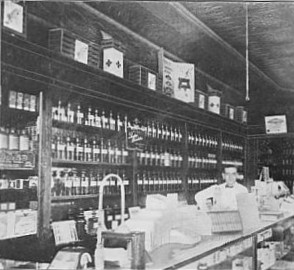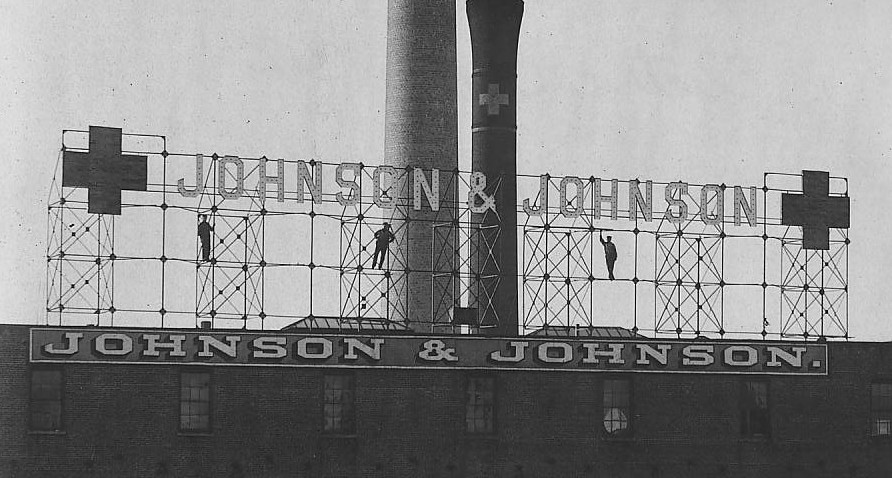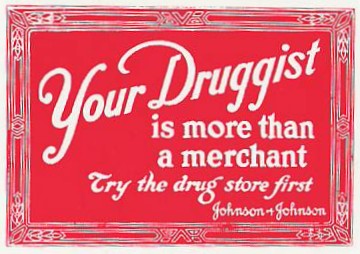Your Druggist is More Than a Merchant
How did the rise of the automobile and the space constraints of an electric sign lead to one of the best-known advertising campaigns in Johnson & Johnson history? And why did Prohibition cause the Company to change it?
The rise of the automobile in the early part of the 20th century had a huge impact on American society. With the advent of mass-produced, affordable cars, people suddenly had much greater mobility. This enabled families to travel far beyond their local corner drugstores to shop for medicines, personal care items and other supplies.

L. & W. De Martini Drugstore, Jersey City, New Jersey, 1917
Druggists, the backbone of the Company’s retail trade, started feeling the pinch of reduced customer traffic and sales. Sensing an opportunity, Johnson & Johnson created a slogan, “Your Druggist is More Than a Merchant,” and made it the theme of a national advertising campaign in 1920. The campaign highlighted the corner druggist’s scientific knowledge and pharmaceutical expertise. It also subtly reminded people that the proprietor of the local corner drugstore wasn’t just an anonymous merchant: he had scientific expertise and he knew his customers and their families well because they were his neighbors.
Scientific Director Fred Kilmer (a former retail pharmacist) felt that retail drugstores were more than just commercial enterprises. According to Kilmer, retail pharmacists were scientifically trained professionals guarding the health of the community, and the Company’s advertising campaign reflected this.

The Enormous Johnson & Johnson Sign, Under Construction
Johnson & Johnson had constructed a huge electric sign in New Brunswick, measuring 115 feet long and over 31 feet high, on the roof of one of its buildings. The sign could be seen by the hundreds of thousands of passengers on the Pennsylvania Railroad as it passed through New Brunswick, and it served as a landmark. It was impossible to miss, especially when it was all lit up at night.
According to Fred Kilmer, the most famous part of the advertising campaign -- the slogan -- started because of the sign. The Company wanted something that would pay tribute to retail pharmacists…but it had to be brief enough to fit on the sign. Here’s what Kilmer said:
“In our magazine advertising we can – and we do – pay tribute to the druggist at length. But a few words is all the sign will carry and all the people can read from the car windows in these days of fast travel. We wanted an easily remembered sentence that would sum up the advantages of dealing with the druggist. And this is the message we flashed: ‘YOUR DRUGGIST IS MORE THAN A MERCHANT.’” [THE RED CROSS MESSENGER, Vol XIII, No. 1, 1920, p. 227]
The sign, lit up to advertise Baby Powder. A description states that the lettering was white, the crosses were red, and the border was yellow.
“Your Druggist is More than a Merchant” was a smashing success and it was soon picked up by retail druggists across the U.S. who started using it in their own advertising. It grew more and more popular with each subsequent advertising campaign.
Everything was going just fine until a respected pharmaceutical journal suddenly refused to carry the ad. According to the editor, the slogan “Your Druggist is More than a Merchant” was an incomplete thought…and too many people were completing it by adding their own ending: “He is a Bootlegger.” (This was during Prohibition in the 1920s, and bootlegging was of course illegal….and popular.)
So the Company’s advertising department quickly came up with its own ending: “Your Druggist is More Than a Merchant. Try the Drug Store First.”

That solved the problem. Publications ran the new ads, and the new slogan went on to achieve even greater success. Pharmacy associations across the United States adopted it as their official slogan, and druggists used it on banners in parades and in “truth” campaigns. In England, it was adapted to become “Your Chemist is More than a Merchant,” and it was translated into French in Canada. The campaign worked wonders for drugstore sales – including sales of Johnson & Johnson products – which started to soar again. Fred Kilmer estimated that the slogan appeared over one billion times in advertising and promotions…not bad for what Kilmer referred to as “an easily remembered sentence that tells a big story.” [THE RED CROSS MESSENGER, Vol. XIII, No. 6, 1921, p. 379]
UPDATE: a computer-savvy reader colorized the sign picture, based on the description above. The sign must've been truly eye-catching in person. Here's the colorized version:


